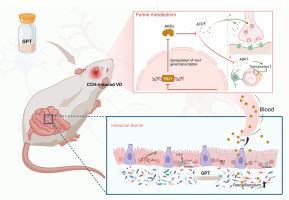桂皮汤通过肠道菌群来源的泛酸调节嘌呤代谢,减轻血管性痴呆。
IF 8.3
1区 医学
Q1 CHEMISTRY, MEDICINAL
引用次数: 0
摘要
背景:血管性痴呆(VD)是第二常见的痴呆类型。慢性脑灌注不足(CCH)是VD的重要诱发因素。CCH可以破坏肠道微生物群(GM),从而加剧VD。桂皮汤(GPT)是一种缓解痴呆的中药方剂。然而,GPT减轻VD的机制尚不清楚。目的:采用多组学技术研究GPT通过gm代谢产物减轻VD的作用机制。方法:采用双侧颈总动脉闭塞模型,通过16S rDNA测序、代谢组学和rna测序(RNA-seq)分析,探讨GPT对VD的缓解作用。我们还使用抗生素治疗、代谢物回填和其他实验来研究转基因及其代谢物的作用。结果:GPT对VD大鼠海马神经元、血脑屏障、肠屏障的损伤有修复作用,显著增加Faecalibaculum的丰度,促进代谢物泛酸(pantothenic acid, PA)的产生,PA被引入血流并在脑内转运。RNA-Seq和双荧光素酶报告基因检测也表明,PA通过抑制Vax1-AK8通路调节嘌呤代谢,抑制三磷酸腺苷(ATP)转化。结论:GPT通过调节Faecalibaculum-PA-Vax1-AK8通路调节脑嘌呤代谢,减轻VD。这项研究为VD的发病机制提供了新的见解,并突出了GPT作为有效治疗和预防药物的潜力。本文章由计算机程序翻译,如有差异,请以英文原文为准。

Guipi Tang alleviates vascular dementia by regulating purine metabolism via gut microbiota-derived pantothenic acid
Background
Vascular dementia (VD) is the second-most common type of dementia. Chronic cerebral hypoperfusion (CCH) is a crucial trigger of VD. CCH can disrupt the gut microbiota (GM), thereby exacerbating VD. Guipi Tang (GPT) is a traditional Chinese medicine (TCM) formula for alleviating dementia. However, the mechanism by which GPT alleviates VD remains unclear.
Purpose
We employed multi-omics techniques to investigate the mechanism of action of GPT in mitigating VD through the metabolites of the GM.
Methods
We used a bilateral common carotid artery occlusion model and 16S rDNA sequencing, metabolomics, and RNA-sequencing (RNA-seq) analyses to explore the mitigating effects of GPT on VD. We also used antibiotic treatment, metabolite-backfilling, and other experiments to investigate the role of the GM and its metabolites.
Results
GPT repaired the damage to the hippocampal neurons, blood-brain barrier, and intestinal barrier in VD rats, significantly increased the abundance of Faecalibaculum, and promoted the production of the metabolite pantothenic acid (PA), which was introduced into the bloodstream and translocated in the brain. RNA-Seq and dual-luciferase reporter gene assays also showed that PA regulates purine metabolism and inhibits adenosine triphosphate (ATP) conversion by inhibiting the Vax1-AK8 pathway.
Conclusion
GPT regulates brain purine metabolism to alleviate VD by modulating the Faecalibaculum-PA-Vax1-AK8 pathway. This study provides new insights into the pathogenesis of VD and highlights the potential of GPT as an effective therapeutic and preventive agent.
求助全文
通过发布文献求助,成功后即可免费获取论文全文。
去求助
来源期刊

Phytomedicine
医学-药学
CiteScore
10.30
自引率
5.10%
发文量
670
审稿时长
91 days
期刊介绍:
Phytomedicine is a therapy-oriented journal that publishes innovative studies on the efficacy, safety, quality, and mechanisms of action of specified plant extracts, phytopharmaceuticals, and their isolated constituents. This includes clinical, pharmacological, pharmacokinetic, and toxicological studies of herbal medicinal products, preparations, and purified compounds with defined and consistent quality, ensuring reproducible pharmacological activity. Founded in 1994, Phytomedicine aims to focus and stimulate research in this field and establish internationally accepted scientific standards for pharmacological studies, proof of clinical efficacy, and safety of phytomedicines.
 求助内容:
求助内容: 应助结果提醒方式:
应助结果提醒方式:


